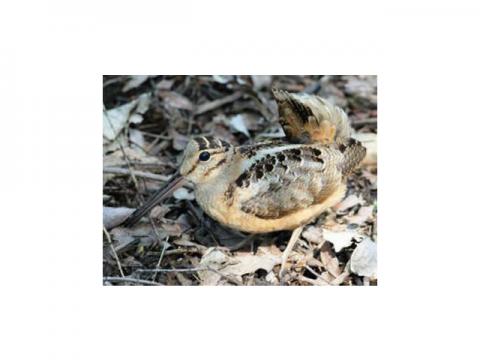Working for Woodcock: Creating Young Forest for Wildlife

Male woodcock launch beautiful springtime mating flights to attract females. Photo courtesy of USFWS.
We have owned a home and land in Wolfeboro, east of Lake Winnipesaukee in central New Hampshire, since 1994. Soon after our purchase, we discovered that we were privileged to own a woodcock singing ground. A singing ground is an open area where male woodcock display in the spring to attract females; after mating, the females then seek out thicker habitat nearby in which to nest and raise their young.
The male woodcock's display is sometimes called a "Sky Dance." Our family has gotten immense pleasure from watching our harbingers of spring perform this rite annually.
Singing grounds vary in size, with a quarter-acre generally proving adequate. Woodcock do their courting in the dim light of evening and morning. The male sounds a nasal, buzzing peent while sitting on the ground. He takes off and flies on twittering wings several hundred feet into the sky, then spirals or zigzags back to the ground, singing a beautiful warbling song as he descends. This display is what attracts and draws in females.
Our property includes about 90 acres of forest, consisting mostly of mixed hardwoods and pines growing on dry, rocky, thin soil, with a few damp areas and a small wetland. Several acres had been cleared for the house and views. These acres were returning to shrubby low growth and young trees at the time of our purchase, and woodcock were using them in spring, summer, and fall.
Trees left after timber harvest
But as time went by, we realized that we were not seeing as many male woodcock displaying in the spring, due to the maturing of the trees on our property. We had very few areas of low, shrubby growth remaining.

In 2015 we participated in a New Hampshire Coverts Project Workshop sponsored by the University of New Hampshire Cooperative Extension and New Hampshire Fish and Game Department – both active partners in the Young Forest Project and the Woodcock Conservation Initiative. The workshop proved to be fascinating and very educational, and it confirmed our suspicions: to have woodcock, as well as many other kinds of young forest wildlife, shrubby habitat is essential. This type of habitat has been diminishing – both on our property and regionwide. Today, the American woodcock is considered a Species of Greatest Conservation Need in 20 states in the East and the Midwest.
The next step? We hired a licensed forester to evaluate our property. He helped us develop a forest management plan and coordinated a timber harvest that will ultimately increase the amount of young forest on our acreage. Additional help and guidance were provided by our county Cooperative Extension forester and by a New Hampshire state wildlife biologist, as well as a wildlife biologist from the Ruffed Grouse Society. What resulted was a harvest designed in a way that would provide the best habitat given our forest's tree species and ecology.
Bob and Trish Leipold
The timber harvest took place in October 2016, when the land was dry – conditions allowing the harvesting equipment to tread lightly, minimizing possible erosion. Fall harvesting near the end of the growing season, combined with a careful placement and orientation of harvest areas, improve the chances for vigorous regeneration of aspen, a fast-growing tree that yields optimal habitat for woodcock and grouse.

The projected regrowth of small trees and shrubs will provide nesting and feeding habitat for a large number of songbirds, browse for deer and moose, wildflowers
and flowering shrubs for pollinating insects, and improved mast production (nuts and berries) from oak, beech, cherry, and hophornbeam trees that were left near the harvest areas and that will regrow vigorously in years to come, thanks to the increased sunlight they'll now receive. In total, there are around 12 acres of new patch cuts on our land, ranging in size from 1 to 6 acres.
We expect to see results in only a few years – actually, it could be even sooner. By next spring – only a few months away – we may hear more woodcock singing, since male woodcock often use log landings and newly created patch cuts to perform their exciting and beautiful sky dance.
As trees grow back in the harvested areas, females will find good nesting habitat, and woodcock of both sexes will enjoy expanded feeding opportunities. After 15 to 20 years, the harvested trees will have regrown to the point that they'll be too old to support some young forest wildlife. Then it will be time to cut adjacent areas to refresh the benefits for all those species that require very young growth to prosper.
Story by Bob and Trish Leipold, New Hampshire Coverts Project volunteers. First published in Winter 2017 Taking Action for Wildlife newsletter.